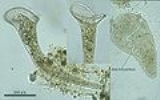
Heterotrich
Encyclopedia
The heterotrichs are a class of ciliate
s. They typically have a prominent adoral zone of membranelle
s circling the mouth, used in locomotion and feeding, and shorter cilia on the rest of the body. Many species are highly contractile, and are typically compressed or conical in form. These include some of the largest protozoa
, such as Stentor and Spirostomum
, as well as many brightly pigmented forms, such as certain Blepharisma.
A number of ultrastructural details characterize the group. The cilia on the body are in dikinetids, in which either the anterior one or both kinetosomes may be ciliated, and which are associated with fibers composed of overlapping postciliary microtubule
s, called postciliodesmata and found only in this group and the closely related Karyorelictea
. A series of oral polykinetids, each containing two or three rows of kinetosomes, support the membranelles. These run from the left to the anterior of the mouth, and often spiral out of the oral cavity. The macronucleus is divided by external microtubules, whereas in the Karyorelictea it forms by differentiation of micronuclei, and in all other ciliates it is divided by internal microtubules.
Traditionally the heterotrichs have been treated as a subgroup of spirotrich
s, but more recent work has found that they are not closely related to the other groups placed there, and accordingly they tend to be given their own class. Most belong to the order Heterotrichida; the position of the other orders is not clear, and Lynn has suggested that they do not really belong here, tentatively returning some to the Spirotrichea and treating others as a new class (Armophorea).
Ciliate
The ciliates are a group of protozoans characterized by the presence of hair-like organelles called cilia, which are identical in structure to flagella but typically shorter and present in much larger numbers with a different undulating pattern than flagella...
s. They typically have a prominent adoral zone of membranelle
Membranelle
Membranelles are structures found around the mouth, or cytostome, in ciliate protists. They are typically arranged in series, to form an "adoral zone of membranelles," or AZM, on the left side of the buccal cavity . The membranelles are made up of kinetosomes arranged in groups to make up...
s circling the mouth, used in locomotion and feeding, and shorter cilia on the rest of the body. Many species are highly contractile, and are typically compressed or conical in form. These include some of the largest protozoa
Protozoa
Protozoa are a diverse group of single-cells eukaryotic organisms, many of which are motile. Throughout history, protozoa have been defined as single-cell protists with animal-like behavior, e.g., movement...
, such as Stentor and Spirostomum
Spirostomum
Spirostomum is a genus of free-living ciliate protists, belonging to the class Heterotrichea. Species of Spirostomum are found in both salt and fresh water. All are elongated, flexible and highly contractile. Although unicellular, members of some species can grow as long as .-Appearance and...
, as well as many brightly pigmented forms, such as certain Blepharisma.
A number of ultrastructural details characterize the group. The cilia on the body are in dikinetids, in which either the anterior one or both kinetosomes may be ciliated, and which are associated with fibers composed of overlapping postciliary microtubule
Microtubule
Microtubules are a component of the cytoskeleton. These rope-like polymers of tubulin can grow as long as 25 micrometers and are highly dynamic. The outer diameter of microtubule is about 25 nm. Microtubules are important for maintaining cell structure, providing platforms for intracellular...
s, called postciliodesmata and found only in this group and the closely related Karyorelictea
Karyorelictea
All ciliate possess multiple dimorphic nuclei which have separated the functions of protein synthesis, preformed by the macronuclei or somatic-nuclei, and heritable DNA replication, performed by the micronuclei or germ-line nuclei...
. A series of oral polykinetids, each containing two or three rows of kinetosomes, support the membranelles. These run from the left to the anterior of the mouth, and often spiral out of the oral cavity. The macronucleus is divided by external microtubules, whereas in the Karyorelictea it forms by differentiation of micronuclei, and in all other ciliates it is divided by internal microtubules.
Traditionally the heterotrichs have been treated as a subgroup of spirotrich
Spirotrich
The spirotrichs are a large and distinctive group of ciliate protozoa. They typically have prominent oral cilia in the form of a series of polykinetids, called the adoral zone of membranelles, beginning anterior to the oral cavity and running down to the left side of the mouth. There may also be...
s, but more recent work has found that they are not closely related to the other groups placed there, and accordingly they tend to be given their own class. Most belong to the order Heterotrichida; the position of the other orders is not clear, and Lynn has suggested that they do not really belong here, tentatively returning some to the Spirotrichea and treating others as a new class (Armophorea).

